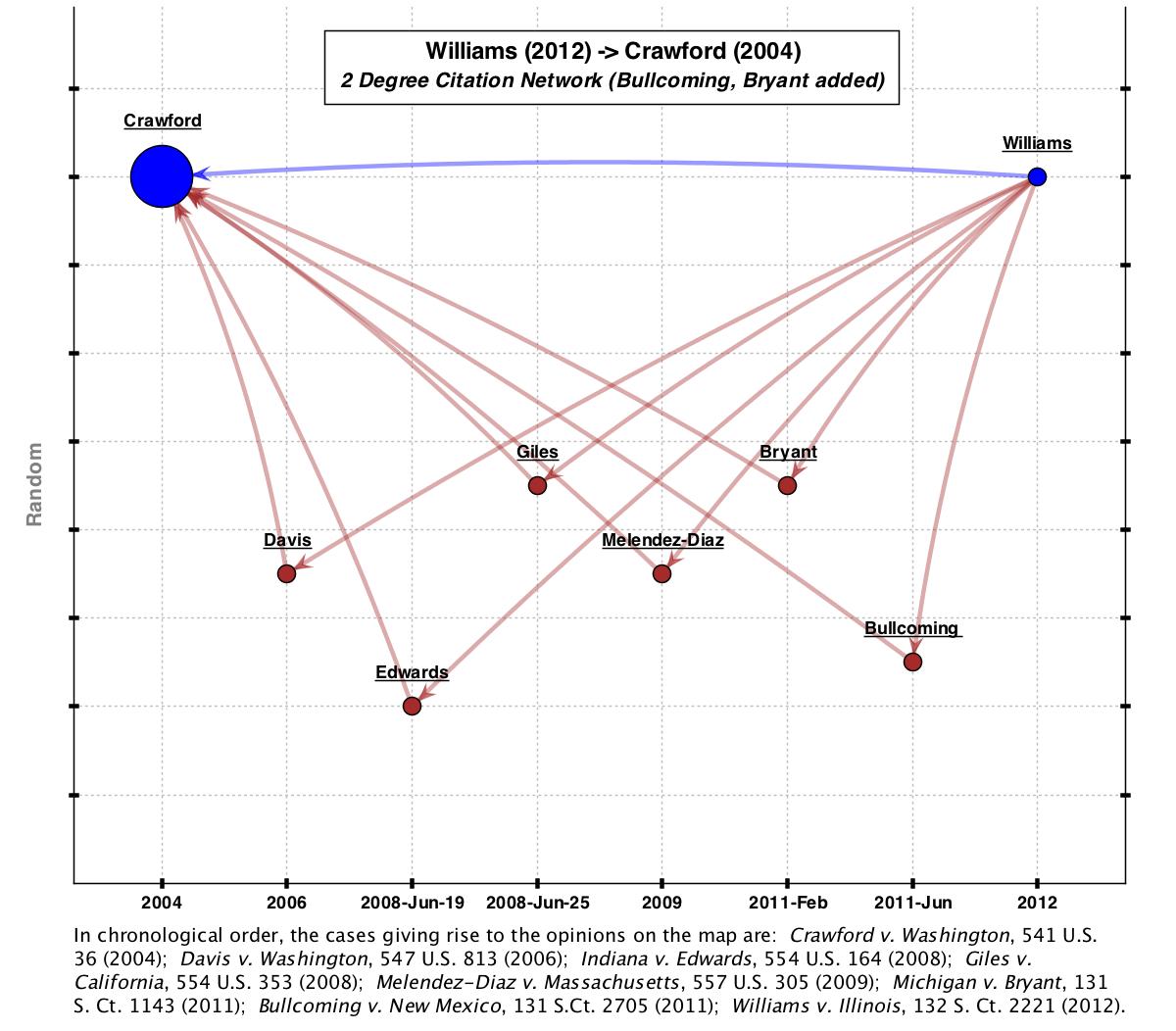Ten years ago, the Supreme Court revolutionized Confrontation Clause jurisprudence in Crawford v. Washington. To celebrate Crawford‘s 10-year birthday, the Michigan Law Review has just published an online retrospective featuring fantastic debate and analysis about the doctrine’s path over the past decade. As I read the essays, I realized that mapping post-Crawford jurisprudence could be both helpful to 6th Amendment studies and revealing about the challenges of visualizing Supreme Court citation networks. Over the next few posts then, I will explore these challenges by constructing Confrontation Clause maps.
One great advantage offered by a post-Crawford case study is that it theoretically implicates a small closed universe of cases. After all, Crawford is only 10 years old. My first goal was to see if I could automatically “capture” all the important cases in this doctrine using the Mapper’s citation-network algorithm. As explained in this video, this algorithm creates networks by looking for n-degrees of connection between any two user-specified cases.
To generate the network, I simply needed two cases that defined the earliest and latest rulings in the doctrine. Crawford itself is the obviously starting point. For the endpoint, I chose the Court’s latest prominent pronouncement, 2012’s Williams v. Illinois. Now to keep things simple, I asked the algorithm to only look for 2-degree connections. Thus, it generated a network of cases that (a) were cited by Williams; and (b) themselves cited to Crawford. Here’s the result (you can click on the image to see a full-sized version of the map complete with links to the underlying opinions):
Although I am no 6th Amendment expert, I could immediately tell that this map was incomplete. Where were Bullcoming v. New Mexico and Michigan v. Bryant? I recalled that Williams had discussed (cited) both of those two important 2011 cases, yet they did not show up. The issue here turns out to be a technical problem related to the Court’s practice when invoking to recent decisions that don’t yet have proper reporter cites. In Williams, for example, cites to Bullcoming look like this “564 U. S. ___”. This practice turns out to be a real pain for the computer bots that parse opinions.
Now I have alerted the gurus over at the Free Law Project (which generously provides the Courtlistener database and API for all the world, including our Project, to use) about the issue and they’ll deal with it when time permits. In the meantime, I simply added Bullcoming and Bryant into the network by hand. Here is what the “fixed” 2-degree network looks like:
This looked a lot better to me, but I wanted to check it against expert opinion. So I turned to Prof. George Fisher‘s article in the Michigan Law retrospective mentioned above. In it, Prof. Fisher suggests that there have been “eight major rulings” in the Crawford line since 2004. These are: (1) Hammon v. Indiana (2006); (2) Davis v. Washington (2006); (3) Wharton v. Bockting (2007); (4) Giles v. California (2008); (5) Melendez-Diaz v. Massachusetts (2009); (6) Michigan v. Bryant (2001); (7) Bullcoming v. New Mexico (2011); and (8) Williams v. Illinois (2011).
So how did the algorithm do? Not bad. Looking only at the 2-degree connections between Williams and Crawford, the network contains all but one of the rulings Prof. Fisher identifies. The only case that is really missing is Wharton. (Although Hammon does not appear on the map, it was decided with Davis in 2006 and published in the same opinion). The only case pulled via the 2-degree method in that Prof. Fisher did not include on his list is Edwards. Although slightly underinclusive and overinclusive, the citation-network approach provided a great first cut at identifying the key cases in the Crawford–Williams line.
In the next post, we’ll look beyond the first cut and consider the problem of under- and over-inclusiveness in more detail. Stay tuned!



Hi, you might be interested by the work done here on a plugin for Gephi to do antagonism-based community detection on a network : https://github.com/jacomyal/ABCD-Gephi-Plugin